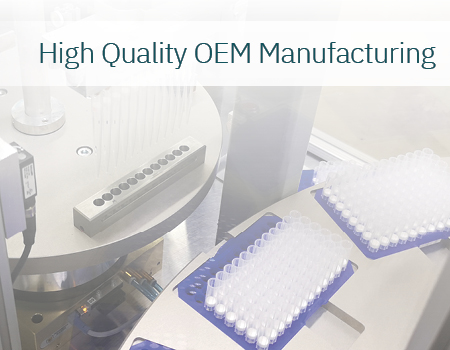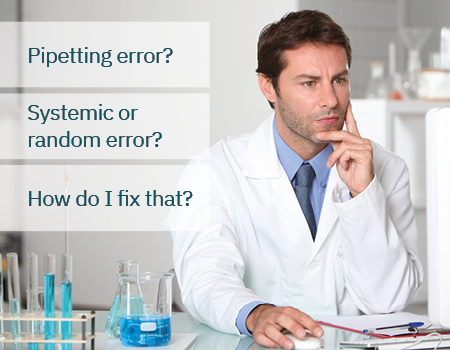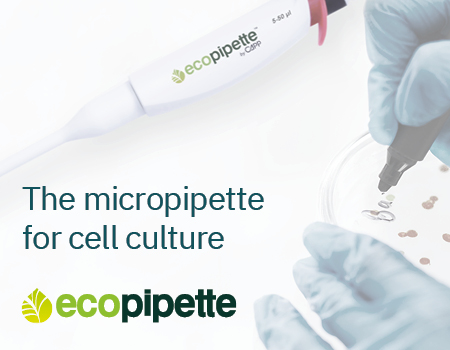FAQs and applicational highlights
Developing good pipetting technique is critical for producing dependable results and it is achievable with the right guidance. For new scientists, we recommend starting with our guide on common pipette handling errors to develop an awareness of potential pitfalls when using micropipettes. By developing a clear understanding of pipetting error, it becomes easier to recognize where you need to improve your micropipette technique. Second, we recommend practicing your pipette technique by aspirating a fixed volume of distilled water ten times, onto a weighing boat on a calibrated balance. Take note of the average of the ten values and determine your systematic error. As you pipette each week, check to see if your systematic error is reducing. Third, select a premium micropipette such as the CAPP Ecopipette that is designed to help you improve your micropipette technique. This ergonomic pipette feels comfortable in the hand and reduces strain - a major contributor to poor pipette technique.
Mechanical pipettes are categorized into two major categories i.e., air displacement pipettes and positive displacement pipettes. Air displacement pipettes are the preferred choice for most laboratory liquid transfers because of their wide range of application. Positive displacement mechanical pipets are less common because they are highly specialized for handling challenging liquids. Modern air displacement mechanical pipettes function by drawing liquid into plastic pipette tips with an air pocket between the plunger and the liquid to be transferred. The air pocket creates a push or pull effect on the liquid, facilitating transfer. Air displacement pipettes come in a range of form factors including single-channel and multichannel varieties. Visit our helpful guide to learn more about the different types of mechanical pipets.
If you are in the market for a brand-new micropipette, you can order directly through our website. CAPP manufactures a wide range of high-quality pipettes tailored to fit your budget. With several micropipettes to choose from, you'll be spoiled for choice as you scroll through the various automatic pipettes that CAPP has on offer. Simply sroll down to explore the different micropipettes in CAPP's portfolio. Additionally, you can test our micropipettes for free through our global distributor network. Simply choose the micropipette that you are interested in and click Test for free or Find a distributor.
One of the most common pipette handling errors is pipetting too fast. Although this may seem desirable for increased efficiency, it will result in inaccuracies in sample loading and offloading. Slowing down and applying constant pressure on the plunger reduces errors. Another error typical of inexperienced users is pipetting at an angle. Micropipettes work best when used at a near-vertical angle for the forces of physics to do their work. New and old users alike often fail to pay attention to their choice of tips. Only use manufacturer recommended tips such as the ExpellPlus range from CAPP, as these offer the greatest compatibility with your pipettes. Lastly, scientists may forget to prewet their tips before liquid transfer. This may cause evaporative losses of liquid during aspiration while also reducing pipetting accuracy.
Blood separation centrifuges work by spinning blood samples (in collection tubes) at high speeds. The high rotation speeds exert a rotational force on the blood collection tubes that is referred to as the centrifugal force. When blood collection tubes are spun in a blood separation centrifuge, the centrifugal force separates the various components of blood as a function of their density and quantity in the sample. Thus, the various components of blood can be separated into different layers for easy separation by simply running the blood samples in a high-quality blood separation centrifuge such as the CAPPRondo Basic Clinical Centrifuge.
Whole blood is a tissue with several cellular and non-cellular components. The major components of blood are cells, plasma, and platelets (cellular fragments involved in clotting). Blood consists of two types of cells i.e., red blood cells (erythrocytes), and white blood cells (leukocytes). Erythrocytes are the blood cells that distribute oxygen from the lungs to all parts of the living organism. Leukocytes, as part of the immune system, are responsible for attacking any infectious cells, thereby keeping the organism healthy. Leukocytes can be furthermore categorized into lymphocytes, monocytes, eosinophils, basophils, and neutrophils (granulocytes). The components of whole blood can be separated using blood separation techniques such as centrifugation. Blood separation allows scientists to provide treatments and study disease markers using the different components of blood.














